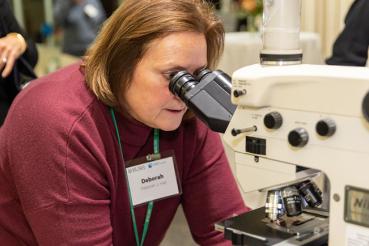Throughout our lives, our bodies continuously break down old bone tissue and form new bone tissue to replace it. But for the 10 million Americans with osteoporosis, bone tissue forms too slowly, breaks down too quickly, or both. When this happens, bones become thin, fragile and prone to fracture.
Fortunately, there here have been tremendous advances over the past several years in treatments for osteoporosis.
Whether you have the condition, care for someone who has it or want to learn the best strategies for avoiding it, you should know the following five things about osteoporosis.
1. Prevention should start early.
Though osteoporosis usually occurs in people older than 65, its underlying causes can stretch back to childhood.
We form about 90% of our peak bone mass before we turn 20 — and the less we form then, the more likely we are to develop the condition later on, says Sonali Khandelwal, MD, a rheumatologist at Rush University Medical Center.
While genes and race play a role in this process, environmental factors, lifestyle, medical conditions and even certain medications can all adversely impact bone health. Therefore, everyone can take steps to prevent bone loss.
2. Getting enough calcium and vitamin D is only the first step.
Calcium and vitamin D are minerals found in our bodies as well as in foods such as milk and yogurt, helps us form and maintain healthy bones.
“This is very important, particularly during childhood,” Khandelwal says. “But getting enough vitamin supplementation is only the first step in preventing osteoporosis.”
Lifestyle changes can help reduce other key risk factors:
- Avoid excessive alcohol – that means no more than 1 drink per day for women, and two daily drinks for men
- Don’t smoke cigarettes, or quit if you do smoke.
- Make weight-bearing exercise, such as aerobics or walking with weights, part of your routine. Because bones, like muscles, grow stronger in response to resistance, doing weight-bearing exercise for at least 30 minutes three times a week can help prevent bone loss.
3. Osteoporosis can go undetected for years.
After prevention, the next best thing is early diagnosis, which can help people with osteoporosis limit bone loss by starting treatment as soon as possible. But early diagnosis requires vigilance, because many people with the disease don’t experience symptoms in the early stages.
For that reason, many experts recommend regular bone density scans for women older than 65, whose lighter, thinner bones and decreased estrogen levels make them more likely to develop the disease. However, Khandelwal advises anyone who is considered at risk based on clinical or genetic factors to also get regular scans.
Don’t wait till you sustain a fracture: Bone health is all about prevention and screening,
“Men are not usually thought of as being at risk for bone loss, but osteoporosis-related mortality is higher in men,” Khandelwal explains. “Men should start screening by the age of 70, and earlier than that if they have other risk factors.”
Ask your doctor about your possible risk of bone loss and if you would need a bone density scan.
4. Low bone density doesn't always mean osteoporosis.
If your scan uncovers low bone density, you don't necessarily have osteoporosis. When bone density is lower than normal but not low enough to qualify as osteoporosis, doctors call it osteopenia.
“People with osteopenia have an increased risk of developing osteoporosis, but they may be able to follow a more conservative treatment plan that does not include medication,” Khandelwal says. “Monitoring their bone health over time with bone density screenings every other year bone is important.”
5. Osteoporosis can't be cured, but it can be treated effectively.
Most people with osteoporosis take bisphosphonates, medications that safely and effectively slow bone loss and prevent the fractures it can cause.
“There are also other agents available for more severe bone loss that can build bone,” Khandelwal explains. “The best drug for you will be best determined in a consultation with a bone health specialist, like a rheumatologist or primary care orthopedic doctor.”
Moreover, the same strategies that may prevent osteoporosis — such as weight-bearing exercise, proper calcium intake and avoiding smoking and excess drinking — can also prevent worsening of bone health after diagnosis.
“Don’t wait till you sustain a fracture: Bone health is all about prevention and screening,” Khandelwal says. “Talk to your health care provider to see what steps you can take to optimize your bone strength as you age.”




